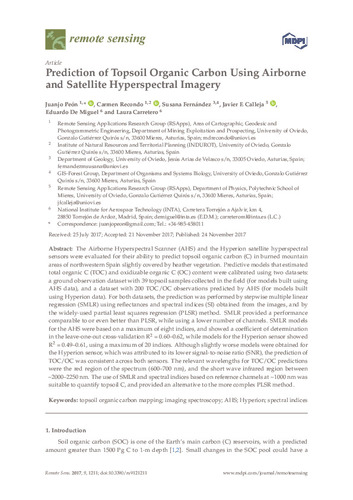Prediction of topsoil organic carbon using airborne and satellite hyperspectral imagery
Fecha de publicación:
Editorial:
MDPI
Versión del editor:
Citación:
Descripción física:
Resumen:
The Airborne Hyperspectral Scanner (AHS) and the Hyperion satellite hyperspectral sensors were evaluated for their ability to predict topsoil organic carbon (C) in burned mountain areas of northwestern Spain slightly covered by heather vegetation. Predictive models that estimated total organic C (TOC) and oxidizable organic C (OC) content were calibrated using two datasets: a ground observation dataset with 39 topsoil samples collected in the field (for models built using AHS data), and a dataset with 200 TOC/OC observations predicted by AHS (for models built using Hyperion data). For both datasets, the prediction was performed by stepwise multiple linear regression (SMLR) using reflectances and spectral indices (SI) obtained from the images, and by the widely-used partial least squares regression (PLSR) method. SMLR provided a performance comparable to or even better than PLSR, while using a lower number of channels. SMLR models for the AHS were based on a maximum of eight indices, and showed a coefficient of determination in the leave-one-out cross-validation R2 = 0.60–0.62, while models for the Hyperion sensor showed R2 = 0.49–0.61, using a maximum of 20 indices. Although slightly worse models were obtained for the Hyperion sensor, which was attributed to its lower signal-to-noise ratio (SNR), the prediction of TOC/OC was consistent across both sensors. The relevant wavelengths for TOC/OC predictions were the red region of the spectrum (600–700 nm), and the short wave infrared region between ~2000–2250 nm. The use of SMLR and spectral indices based on reference channels at ~1000 nm was suitable to quantify topsoil C, and provided an alternative to the more complex PLSR method.
The Airborne Hyperspectral Scanner (AHS) and the Hyperion satellite hyperspectral sensors were evaluated for their ability to predict topsoil organic carbon (C) in burned mountain areas of northwestern Spain slightly covered by heather vegetation. Predictive models that estimated total organic C (TOC) and oxidizable organic C (OC) content were calibrated using two datasets: a ground observation dataset with 39 topsoil samples collected in the field (for models built using AHS data), and a dataset with 200 TOC/OC observations predicted by AHS (for models built using Hyperion data). For both datasets, the prediction was performed by stepwise multiple linear regression (SMLR) using reflectances and spectral indices (SI) obtained from the images, and by the widely-used partial least squares regression (PLSR) method. SMLR provided a performance comparable to or even better than PLSR, while using a lower number of channels. SMLR models for the AHS were based on a maximum of eight indices, and showed a coefficient of determination in the leave-one-out cross-validation R2 = 0.60–0.62, while models for the Hyperion sensor showed R2 = 0.49–0.61, using a maximum of 20 indices. Although slightly worse models were obtained for the Hyperion sensor, which was attributed to its lower signal-to-noise ratio (SNR), the prediction of TOC/OC was consistent across both sensors. The relevant wavelengths for TOC/OC predictions were the red region of the spectrum (600–700 nm), and the short wave infrared region between ~2000–2250 nm. The use of SMLR and spectral indices based on reference channels at ~1000 nm was suitable to quantify topsoil C, and provided an alternative to the more complex PLSR method.
ISSN:
DOI:
Patrocinado por:
Spanish Ministry of Education (Ph.D. Grant "FPU" FPU14/01350), Government of Asturias (Project SV-PA-13-ECOEMP-40 and Ph.D. Grant "Severo Ochoa" BP14-104), University of Oviedo (“Predoctoral Grant”).
Colecciones
- Artículos [37542]
- Explotación y Prospección de Minas [323]
- Indurot [171]
- Investigaciones y Documentos OpenAIRE [8401]
Ficheros en el ítem





